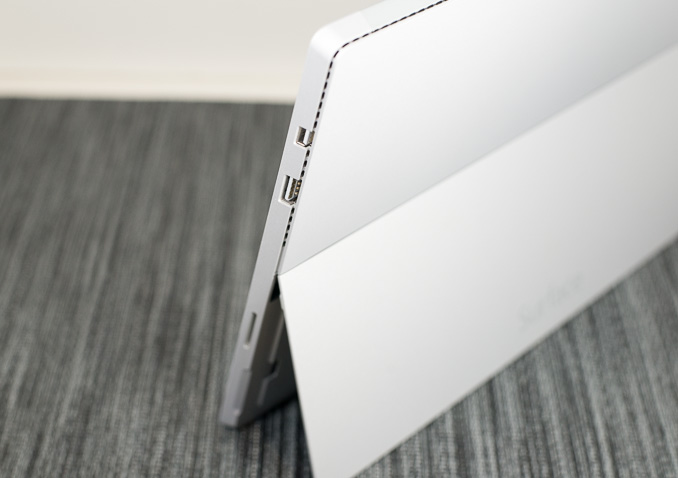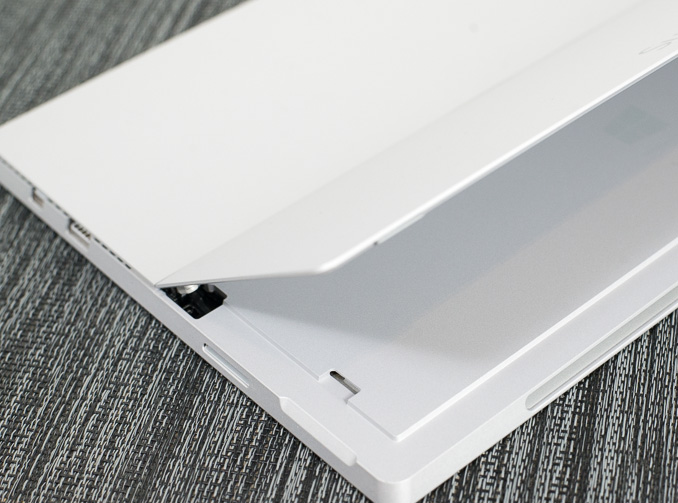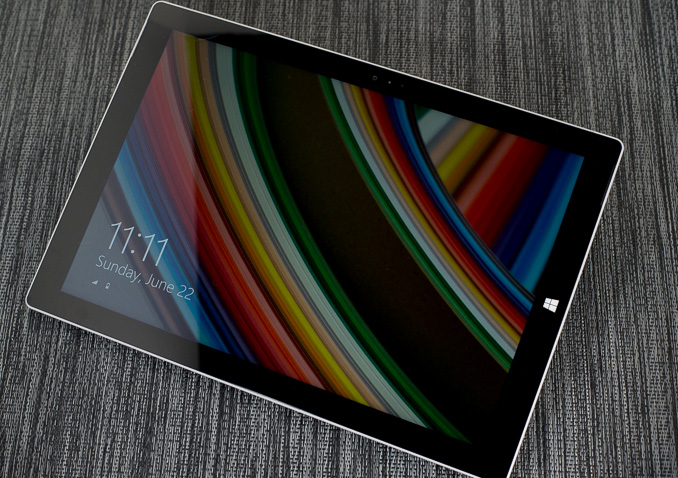Microsoft Surface Pro 3 Review
by Anand Lal Shimpi on June 23, 2014 3:55 AM ESTFinal Words
When I reviewed the first Surface Pro I was intrigued by the idea, but felt it needed a few more iterations to get to the right point. In less than two years what we have in front of us looks very different than Microsoft's original vision for the platform. Display size, aspect ratio and even the mechanics of the whole thing are all quite different. The changes are for the better as Surface Pro 3 is a much better laptop and a much better tablet than any of its predecessors. The device no longer feels cramped and tiring to use as a laptop. The new Surface Pro no longer feels heavy to use as a tablet either. It's truly an improvement on both vectors.
Microsoft might be overselling the design to say that it truly is the only device you need. Like most compromises, Surface Pro 3 isn't the world's best laptop nor is it the world's best tablet. It serves a user who wants a little of column A and a little of column B.
The device's "lapability" is tremendously better than any of its predecessors. While I wrote all of the previous Surface reviews on the very Surface devices I was reviewing, this is by far the most comfortable one to use as a laptop. It's still not perfect, and you still need a fairly long lap to make it work, but the design is finally really usable as a laptop.
As a tablet the thinner and lighter chassis is much appreciated. The new kickstand remains one of the best parts of the design, enabling a flexibility unmatched by any other tablet. Tent mode in particular is awesome for tablet usage models.
Surprisingly enough the move away from Wacom to an active NTrig pen model comes with very few issues. The device could use some tuning of its pen pressure curves. Applying max pressure on the screen now distorts the LCD, something I'm never comfortable doing. But overall the new pen gives up very little and even improves performance and functionality.
The new Type Cover is awesome. The keyboard is probably as good as it's going to get, and the new trackpad is finally usable. The latter isn't perfect but it's so much better than anything that's come before it.
The device also launches with a far more polished version of Windows. With its latest updates, Windows 8.1 is a far cry from where it first started. I still think there's lots of room for improvement, but it's clear that Microsoft is marching towards a more cohesive vision of modern and desktop Windows UIs.
The downsides for Surface Pro 3 are obvious. Windows 8.1 remains a better desktop/notebook OS than a tablet OS. Yet in a device like Surface Pro 3 where you're forced to rely on touch more thanks to a cramped trackpad, I'm often in a situation where I'm interacting with the Windows desktop using the touchscreen - a situation that rarely ends well. As Microsoft improves the behavior of its modern UI apps, I would love to see a rethinking of what touch looks like on the desktop. If Surface Pro 3 exists to blur the lines between laptop and tablet, Windows 9 needs to do a better job of the same. The desktop needs to react better to touch and the modern apps need to feel even more integrated into the desktop.
On the hardware side, the device is a compromise. You have to be willing to give up some "lapability" in order to get a unified laptop/tablet device. Whether what you get as a tablet is worth the tradeoff is going to be up to how good of a tablet OS Windows 8.1 is for you. Personally I find that Android and iOS deliver better tablet experiences particularly when it comes to 3rd party applications. If everything you need on the tablet front is available in the Windows Store however then the point is moot.
Those users upgrading from Surface Pro 2 may notice a regression in performance, particularly when it comes to running prolonged CPU/GPU intensive workloads. In games, the difference can be noticeable. The simple fact is that in becoming a thinner device, Surface Pro 3 inherited more thermal constraints than its predecessors. While performance regressions aren't ideal, in this case I can appreciate what Microsoft has done. From the very beginning I wanted a lower TDP part in a thinner chassis. Had Microsoft done that from the start we wouldn't have seen any performance regression but rather a steady increase over time. From my perspective, Surface Pro 3 is simply arriving at the right balance of thermals and performance - the previous designs aimed too high on the performance curve and required an unreasonably large chassis as a result.
The remaining nitpicks are the same as last time: Microsoft needs to embrace Thunderbolt, and a Type Cover should come with the device. The display's color accuracy is good but grayscale performance needs some work.
Surface Pro 3 is easily the best design Microsoft has put forward. If you were intrigued by the previous designs, this is the first one that should really tempt you over. I was a fan of the original Surface Pro, and with Surface Pro 3 I think Microsoft has taken the hardware much closer to perfection. At this point the design needs more help on the software side than hardware, which is saying a lot for the Surface Pro hardware team. Personally I'd still rather carry a good notebook and a lightweight tablet, but if you are looking for a single device this is literally the only thing on the market that's worth considering. I don't know how big the professional productivity tablet market is, but it's a space that Microsoft seems to have almost exclusive reign over with its Surface line. With its latest iteration, Microsoft is serving that market better than ever.













274 Comments
View All Comments
Da W - Monday, June 23, 2014 - link
I use touch on the desktop all the time and it woks well.ablejo26 - Monday, June 23, 2014 - link
You obviously don't know what you are doing on windows 8.1, I switched from mac air with the pro 2 and its way better. If you are not into learning new OS that's fine to stay with the old as it does the job but if want an experience that gives you a touch and type then do it you wont regret it.mmrezaie - Monday, June 23, 2014 - link
Maybe you are right. I am from oss (linux/unix) world, and as far as I am thinking about it, it feels like two distinct os, and not one unified shell. Don't get me wrong, I like the idea very much, but in the end I returned it because I couldn't see it as developer friendly. I use my macbook air a lot since I am always getting remote shell from my servers.basroil - Tuesday, June 24, 2014 - link
"far as I am thinking about it, it feels like two distinct os, and not one unified shell. "In that case you know linux is a schizoid, since bash is completely different to your desktop environment (despite being necessary and also allowing most software to run), and then each desktop environment is different (gnome, KDE, etc). Hell, it's even crazier because you can't actually expect your program to work out of the box on all systems even if they run the same base OS! (mostly because of desktop environment and default packages)
In windows, you have powershell if you need it, and you never NEED to develop for WinRT and Windows.h concurrently.
darwinosx - Tuesday, June 24, 2014 - link
Oh so he's not doing Windows 8.1 the right way...got it.I'll take an Air over the compromised device any day.
kyuu - Tuesday, June 24, 2014 - link
Your Air is a compromised device, as all laptops are. Compromises are made in the name of portability. Calling the SP3 a "compromised" device as though it's some sort of derogatory term is silly. Engineering is all about compromise.Voldenuit - Monday, June 23, 2014 - link
Yeah, $500 to jump to the 8GB/256GB config is pretty steep.$799 for the base model isn't bad, but you're getting severely compromised RAM and storage and a less capable CPU. As Anand says, the type cover needs to be included as standard at all price points, and the higher SKUs are just too expensive for me to stomach (YMMV).
fokka - Monday, June 23, 2014 - link
exactly this. the jump from 256gb to 512gb is $400, while a new 512gb msata evo costs 280 bucks.basroil - Tuesday, June 24, 2014 - link
The 512gb one isn't necessarily an evo, like the 128gb one that sure as hell isn't (hynix unbranded). If they swapped it out for a 840pro or similar I bet you wouldn't be complaining (costs about 400 )tential - Monday, June 23, 2014 - link
I agree with you but this is MSRP launch day prices. Give this a month or two and you'll see much lower prices. I wouldn't be surprised if the model Anand tested for $1299 was $900-1000 In November.